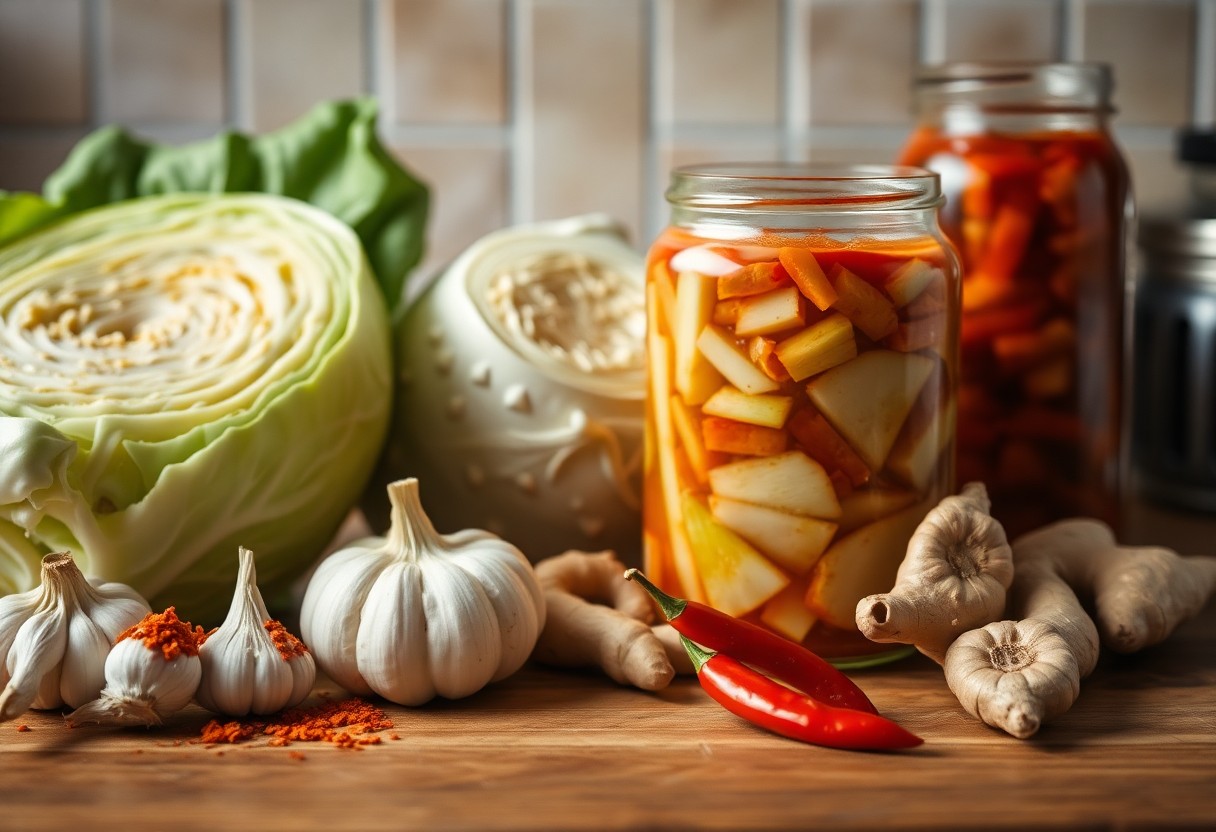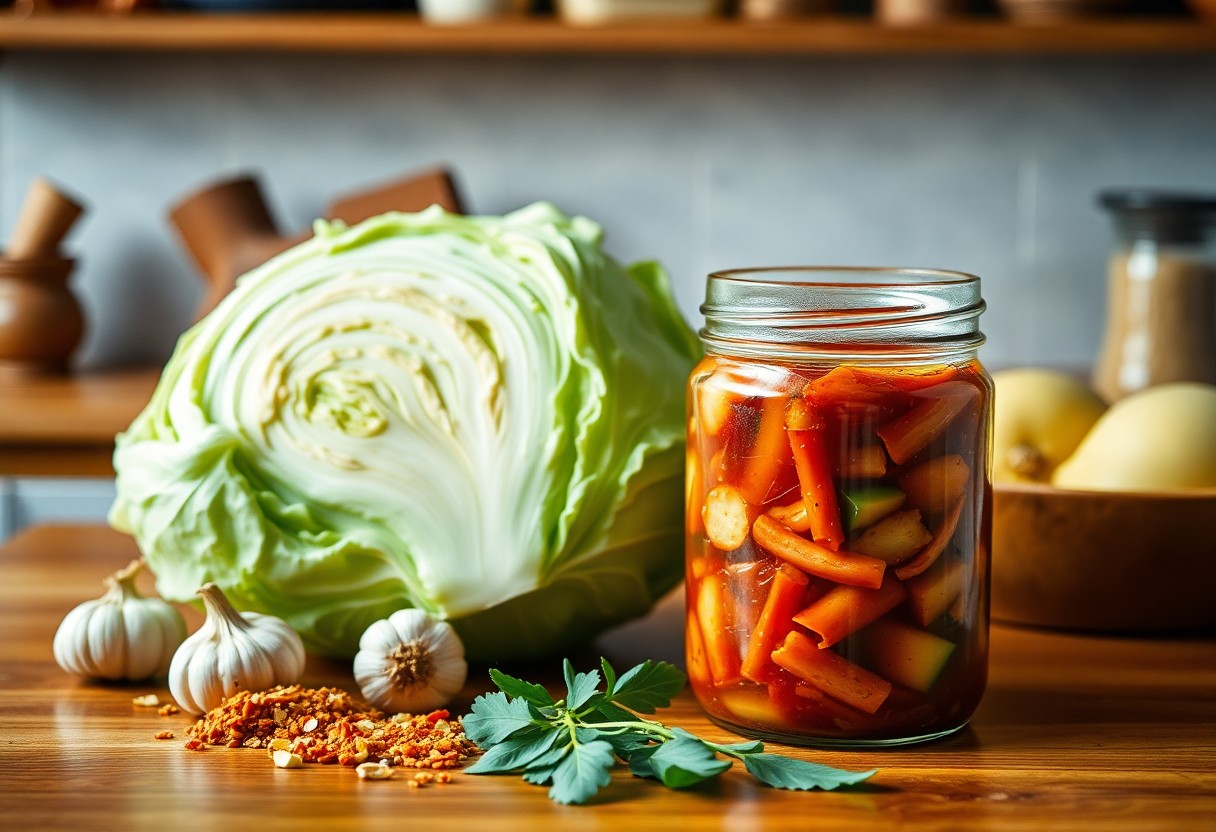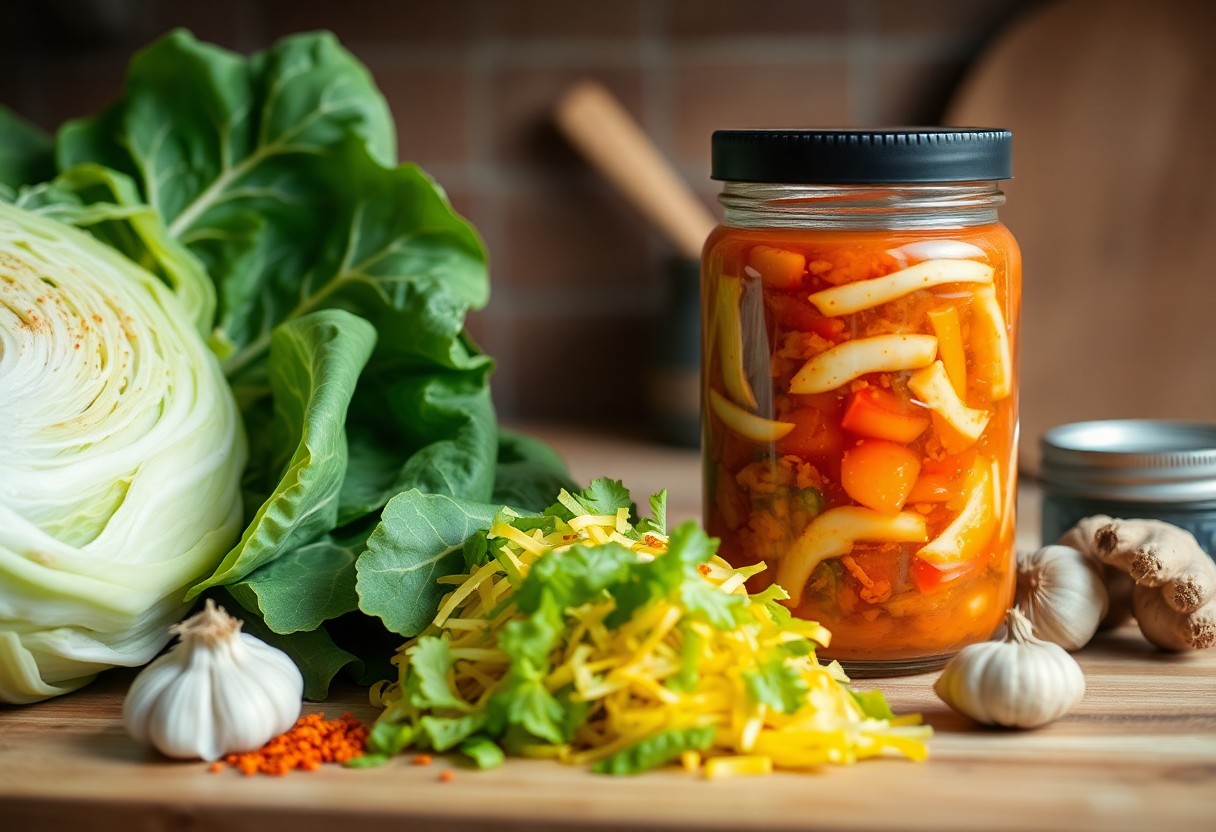How Do You Make Homemade Sauerkraut & Kimchi?
Many fermentation enthusiasts find themselves drawn to making sauerkraut and kimchi at home, and you’ll be amazed at how simple these processes can be. Your journey into fermented foods begins with just a few basic ingredients and tools you likely already have in your kitchen. Both of these probiotic-rich foods share similar techniques, yet each brings its own distinct flavors and health benefits to your table. When you master these fundamental fermentation methods, you’ll save money while creating authentic versions of these traditional foods that surpass their store-bought counterparts in both taste and nutritional value.
Understanding Fermentation
To create delicious sauerkraut and kimchi, you need to grasp the basics of fermentation. This natural process transforms ordinary vegetables into probiotic-rich foods through the action of beneficial bacteria. When you understand how fermentation works, you’ll be better equipped to make these traditional foods at your home successfully.
What is Fermentation?
With fermentation, you’re imperatively creating the perfect environment for beneficial bacteria to thrive. These microorganisms convert the natural sugars in vegetables into lactic acid, which acts as a preservative and gives fermented foods their distinctive tangy flavor. During this process, the vegetables become easier to digest while developing complex flavors and textures.
Benefits of Fermented Foods
There’s a reason why fermented foods have been part of traditional diets worldwide for thousands of years. When you incorporate foods like sauerkraut and kimchi into your diet, you’re adding beneficial probiotics, enhanced nutrients, and improved digestibility to your meals. These foods support your gut health and boost your immune system naturally.
Benefits of fermented foods extend beyond digestive health. You’ll find that regular consumption can improve your vitamin absorption, enhance your mood through the gut-brain connection, and provide your body with beneficial enzymes. The fermentation process also increases the bioavailability of nutrients in your food, making it easier for your body to absorb imperative vitamins and minerals.
Ingredients and Equipment Needed
Clearly, successful fermentation relies on having the right ingredients and proper equipment at your disposal. Before starting your fermentation journey, you’ll need to gather specific vegetables, seasonings, and tools. The quality of your ingredients directly impacts the final taste of your fermented products, so selecting fresh, high-quality components is vital.
Essential Ingredients for Sauerkraut
While sauerkraut might seem complex, it requires just two main ingredients: cabbage and salt. You’ll need fresh, firm cabbage heads and non-iodized salt, such as kosher or sea salt. The salt percentage typically ranges between 1.5% to 2% of the cabbage weight to ensure proper fermentation.
Essential Ingredients for Kimchi
An authentic kimchi recipe calls for Napa cabbage, Korean red pepper flakes (gochugaru), garlic, ginger, fish sauce, green onions, and Korean radish (daikon). You’ll also need sea salt for the initial brining process and rice flour to create the pepper paste mixture.
Essential Korean ingredients give kimchi its distinctive flavor profile. You can find these items at Asian grocery stores or online specialty shops. The quality of your gochugaru significantly influences the final taste, so selecting a reputable brand will enhance your kimchi’s authenticity.
Necessary Equipment
Assuming you’re new to fermentation, you’ll need basic equipment to get started: fermentation vessels (wide-mouth jars or crocks), weights to keep vegetables submerged, airlocks or tight-fitting lids, and clean cutting boards and knives. A kitchen scale helps measure ingredients accurately.
For instance, glass jars work well for small batches, while ceramic crocks are ideal for larger quantities. You’ll want to ensure your containers are clean and properly sized for your batch. Fermentation weights keep vegetables below the brine, preventing mold growth, while airlocks allow gases to escape without letting oxygen in.
How to Make Homemade Sauerkraut
All you need to create traditional sauerkraut at home is cabbage, salt, and patience. This fermented dish offers not only a tangy, crunchy addition to your meals but also provides beneficial probiotics for gut health. Your homemade version will surpass any store-bought alternatives in both flavor and nutritional value.
Step-by-Step Instructions
| Ingredients | Process |
| 1 cabbage head | Shred finely |
| 2 tablespoons salt | Mix with cabbage |
| Clean jar | Pack firmly |
| Weight | Keep submerged |
Tips for Perfect Fermentation
To achieve the best results with your sauerkraut fermentation, maintain consistent room temperature and ensure proper salt ratio.
- Keep fermentation temperature between 65-72°F
- Use non-iodized salt only
- Check daily for any mold formation
- Maintain cabbage under brine
- Knowing when it’s ready by tasting after 1 week
Plus, you’ll want to consider these additional fermentation factors for optimal results.
- Clean all equipment thoroughly
- Leave 2 inches headspace in jar
- Use spring or filtered water if needed
- Store in a dark place while fermenting
- Knowing your ferment is done when bubbling stops
How to Make Homemade Kimchi
Many Korean households have their own unique kimchi recipes passed down through generations. This fermented dish combines Napa cabbage, Korean red pepper flakes (gochugaru), garlic, ginger, and other vegetables into a spicy, probiotic-rich condiment. Your homemade kimchi can be ready in as little as 3-5 days of fermentation, though you can age it longer for stronger flavors.
Step-by-Step Instructions
| Salt and Prep | Salt cabbage for 2 hours, rinse and drain |
| Make Paste | Mix gochugaru, garlic, ginger, and fish sauce |
| Combine | Mix paste with vegetables and pack into jar |
| Ferment | Leave at room temperature for 3-5 days |
Tips for Flavor and Texture
Assuming you want to create authentic kimchi flavors, consider these important elements:
- Use Korean red pepper flakes for authentic taste
- Add fresh ginger and garlic generously
- Include fish sauce for umami depth
- Maintain proper salt levels
Recognizing when your kimchi has reached optimal fermentation comes with practice and observation.
To enhance your kimchi-making skills further:
- Experiment with different vegetable combinations
- Adjust spice levels to your preference
- Try adding seafood like salted shrimp
- Control fermentation speed with temperature
Recognizing the perfect balance of flavors will help you develop your signature kimchi recipe.
Common Factors Influencing Fermentation
Unlike other food preservation methods, fermentation requires careful attention to several key factors that affect the final product’s taste, texture, and safety. The primary elements you need to monitor include temperature, salt concentration, and time. Your success in making sauerkraut and kimchi depends on maintaining proper conditions throughout the process. This understanding helps you achieve consistent, delicious results every time.
Temperature and Environment
| Room Temperature | 65-72°F (18-22°C) |
| Storage Temperature | 32-50°F (0-10°C) |
Fermentation thrives in specific environmental conditions that you can easily maintain in your home. Keep your ferments away from direct sunlight and maintain consistent room temperature. Your vegetables will ferment faster in warmer conditions and slower in cooler environments.
Time and Fermentation Levels
While fermentation times vary based on your taste preferences, most sauerkraut and kimchi recipes require 3-21 days at room temperature. You can taste your ferments periodically to determine when they’ve reached your desired flavor profile.
A longer fermentation period results in a stronger, more sour taste and softer texture. You can slow down the fermentation by moving your containers to the refrigerator once they reach your preferred taste. Your fermented vegetables can last several months when properly stored in cool conditions.
Troubleshooting Tips
Your fermentation journey might encounter a few bumps along the way, but most issues are easily fixable. Keep your vegetables fully submerged in brine, maintain proper temperature between 65-75°F, and ensure your containers are clean. Check for proper salt concentration and avoid using iodized salt. After mastering these basics, you’ll be able to spot and prevent common fermentation problems before they occur.
Signs of Successful Fermentation
You’ll notice several indicators that your fermentation is progressing well. Look for tiny bubbles rising to the surface, a slightly sour but pleasant aroma, and a gradual change in color from bright to slightly translucent. The brine should become cloudy, and the vegetables should maintain their crispness while developing that distinctive tangy flavor.
What to Do If It Goes Wrong
Tips for salvaging your ferment include removing any surface mold (if it’s white), adjusting salt levels, and relocating to a cooler spot if fermenting too quickly. Trust your senses – discard if you notice strong unpleasant odors, slimy texture, or pink/orange coloring.
The most common fermentation issues stem from improper temperature control and contamination. If you spot black or green mold, strong offensive odors, or mushy vegetables, it’s best to start fresh. Always use clean equipment, maintain proper salt ratios, and keep ferments at room temperature. When in doubt about safety, prioritize food safety and begin a new batch.
To wrap up
Drawing together all the steps, you’ll find that making sauerkraut and kimchi at home is both rewarding and straightforward. Your success depends on maintaining proper salt ratios, ensuring clean equipment, and allowing adequate fermentation time. Whether you choose the simple cabbage-and-salt combination of sauerkraut or the spicy, complex flavors of kimchi, you’re participating in an age-old tradition of food preservation. By following these methods, you’ll create probiotic-rich ferments that can last for months in your refrigerator, providing you with healthy, flavorful additions to your meals.








